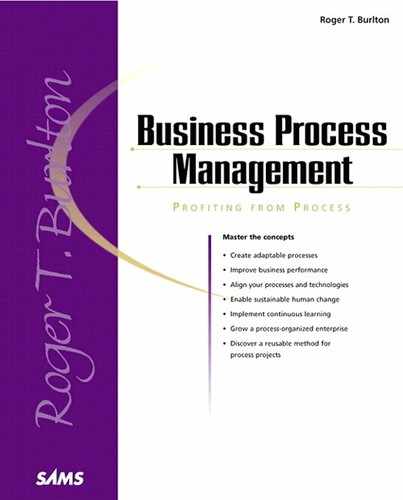Validating the Mission
This first step ensures that the mission, general direction, organizational purpose, and intent of the business, and other related aspects of the “Organization-in-Focus” direction are known, commonly understood, and accepted. The mission might have to be articulated formally for the first time or perhaps just reviewed and validated. During this step, examine documented statements and have the management team responsible for the initiative evaluate the statements for current appropriateness. Look for any fundamental directional change that might affect performance or the plans for process management. Without a clear answer to the fundamental question “What business are we in?”, it would be impossible to chart a course of change or to manage what is put in place.
Figure 10.3 shows an example of the knowledge produced as a result of validating a business mission.
Techniques
Validation techniques are typically used in traditional strategic planning for a chosen planning horizon—typically two to five years. These involve a number of planning and analysis concepts, such as
Mission— What is the organization in business to “do”?
Value proposition— What is our distinguishing differentiation in the marketplace?
Vision— What does the organization strive to “be” at the end of the planning period?
Goals— What does the organization plan to accomplish in the planning period?
Objectives— What results does the organization plan to deliver?
Key performance indicators— What measures of performance will be used to set targets and evaluate progress?
Strategies— What methods or approaches are used to reach the goals and performance targets?
Barriers— What obstacles will have to be overcome to be successful?
Lessons Learned
The mission validation step is inextricably linked with or dependent on the organization’s business strategy. As such, those who feel that this step treads on their toes might resist. Be ready for opposition or difficulty in marshaling the required support. Remind everyone that you aren’t questioning the mission statement or the business strategy, just trying to understand it, so that it can guide further decision making and direction setting within the following stages of the Process Management Framework.
The work here should cull whatever is possible from existing documents and should reference the sources.
There might have been a number of attempts at this, so don’t come across as wanting to do another document review just for its own sake. Build on what already exists within the organization, validating where it’s possible and creating only where it’s necessary. Using mocked-up models that can be tested and reconfigured easily as starting points might be better than building from scratch.
Coordinate this activity closely with the next step in the Business Context phase, which analyzes business drivers, and the other stakeholder-based work. Use joint presentations and workshops to validate both at the same time. It will then be clearer to everyone why you are doing any of these steps.
Conduct confidential interviews followed by executive workshops for providing insight and consensus. Use techniques familiar to managers, if those techniques make them more comfortable. The technique is less important than the insight gained in the collaboration.

